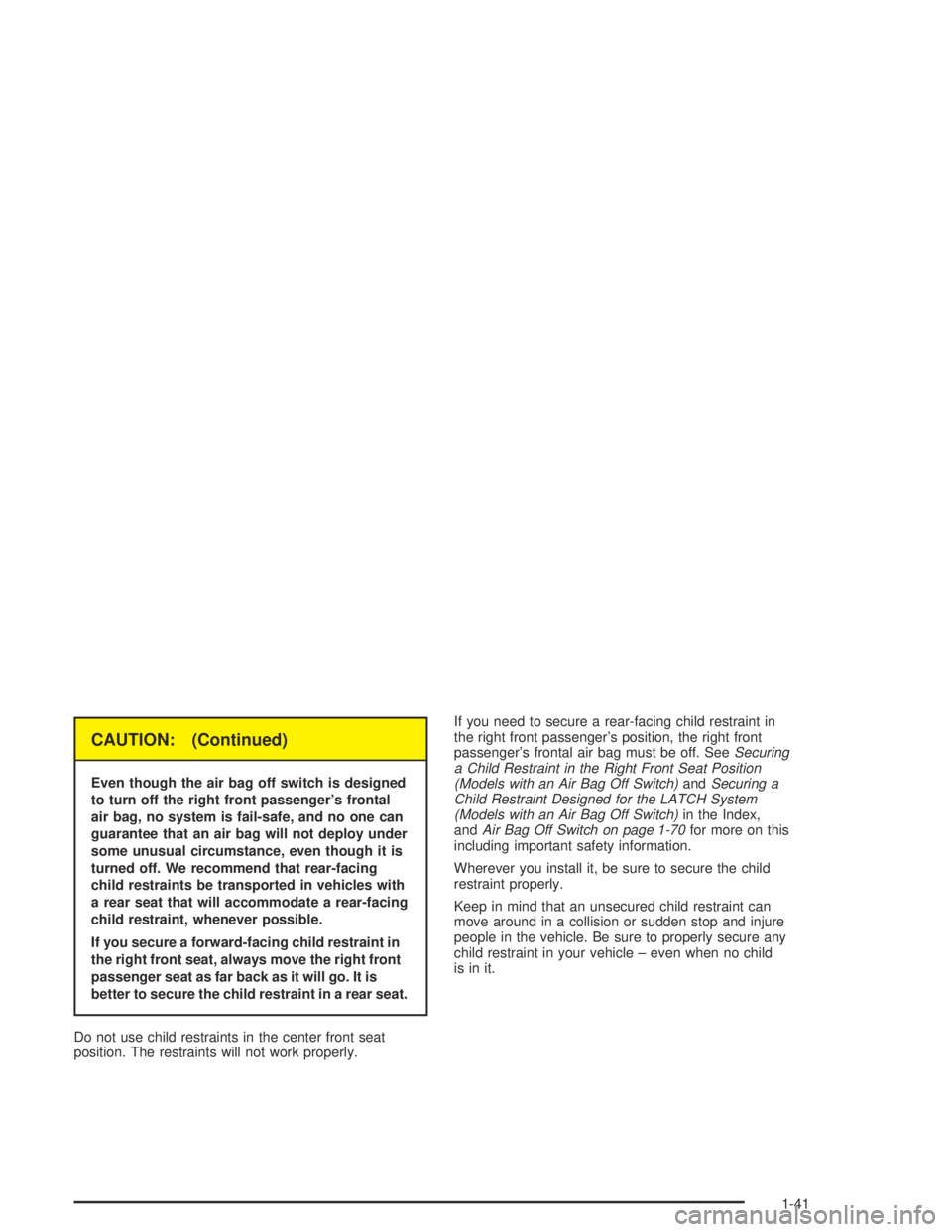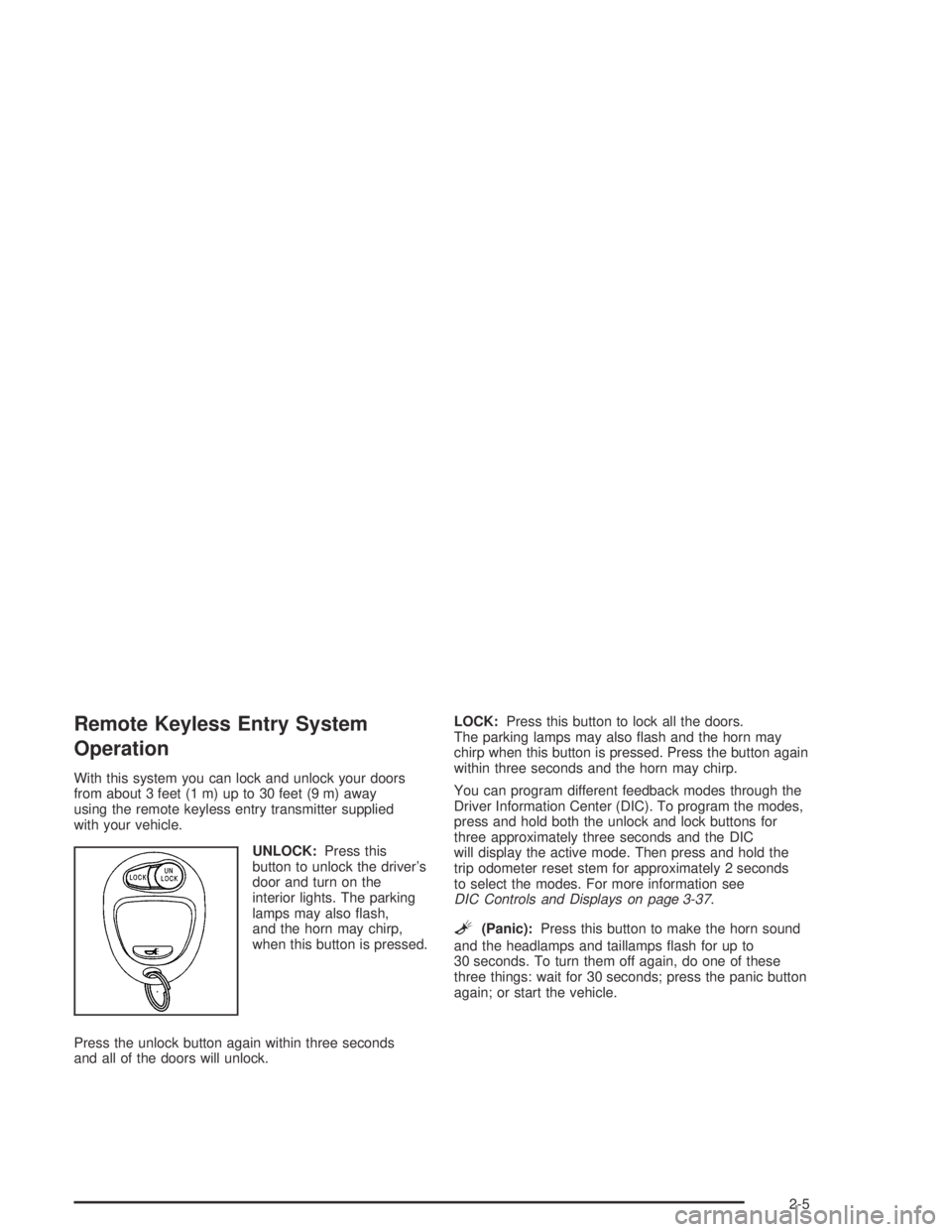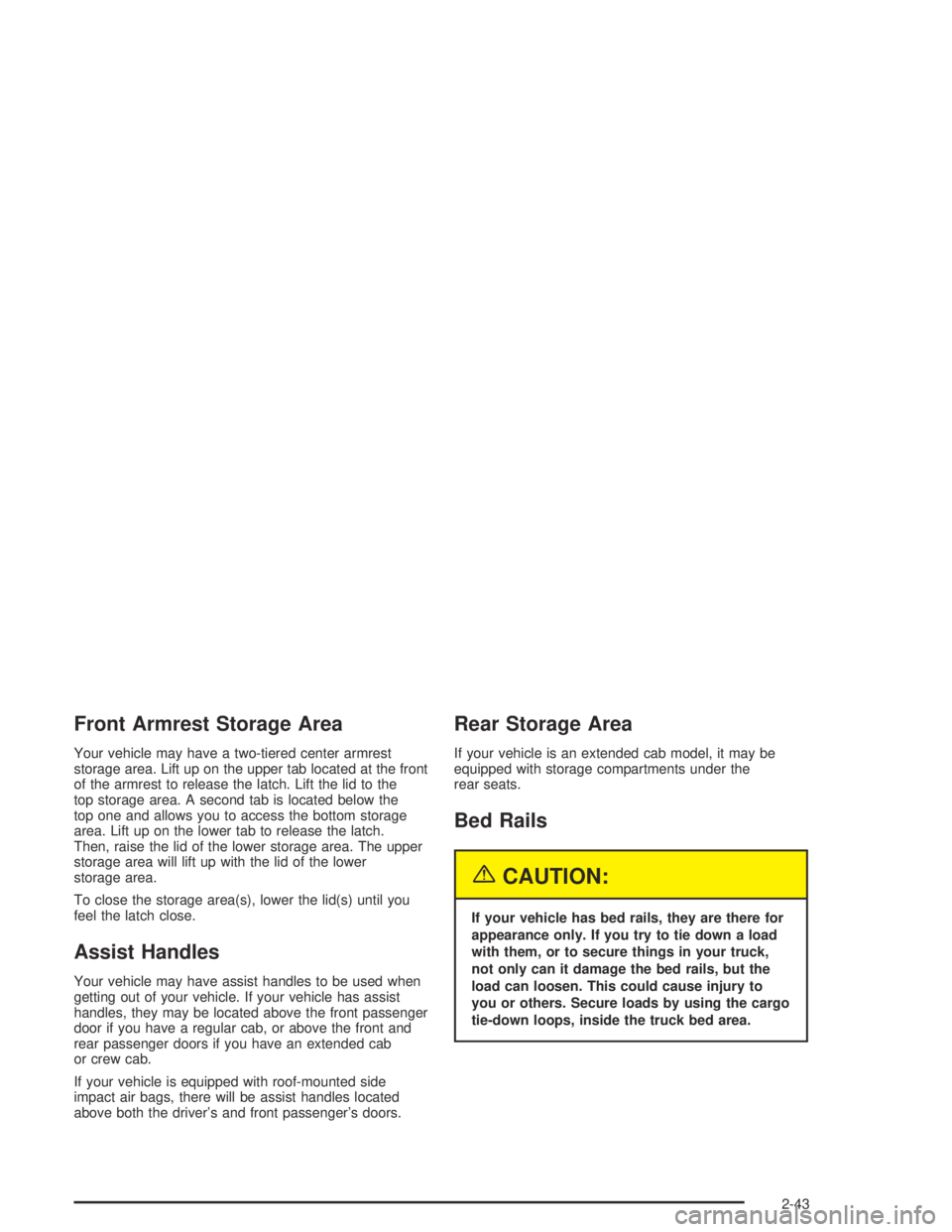2004 GMC CANYON ECO mode
[x] Cancel search: ECO modePage 47 of 420

CAUTION: (Continued)
Even though the air bag off switch is designed
to turn off the right front passenger’s frontal
air bag, no system is fail-safe, and no one can
guarantee that an air bag will not deploy under
some unusual circumstance, even though it is
turned off. We recommend that rear-facing
child restraints be transported in vehicles with
a rear seat that will accommodate a rear-facing
child restraint, whenever possible.
If you secure a forward-facing child restraint in
the right front seat, always move the right front
passenger seat as far back as it will go. It is
better to secure the child restraint in a rear seat.
Do not use child restraints in the center front seat
position. The restraints will not work properly.If you need to secure a rear-facing child restraint in
the right front passenger’s position, the right front
passenger’s frontal air bag must be off. SeeSecuring
a Child Restraint in the Right Front Seat Position
(Models with an Air Bag Off Switch)andSecuring a
Child Restraint Designed for the LATCH System
(Models with an Air Bag Off Switch)in the Index,
andAir Bag Off Switch on page 1-70for more on this
including important safety information.
Wherever you install it, be sure to secure the child
restraint properly.
Keep in mind that an unsecured child restraint can
move around in a collision or sudden stop and injure
people in the vehicle. Be sure to properly secure any
child restraint in your vehicle – even when no child
is in it.
1-41
Page 54 of 420

Securing a Child Restraint
Designed for the LATCH System
(Models with an Air Bag Off Switch)
Regular Cab Models and Extended
Cab Models without Rear Seats
Your vehicle has air bags. Regular cab models and
extended cab models without rear seats have an air bag
off switch on the instrument panel you can use to turn off
the right front passenger’s frontal air bag. SeeAir Bag
Off Switch on page 1-70for more on this including
important safety information.Unless the right front passenger’s frontal air bag has
been turned off,neverput a rear-facing child restraint in
this vehicle. Here is why:
{CAUTION:
A child in a rear-facing child restraint can be
seriously injured or killed if the right front
passenger’s frontal air bag in�ates. This is
because the back of the rear-facing child
restraint would be very close to the in�ating
air bag. Do not use a rear-facing child restraint
in this vehicle unless the air bag has been
turned off.
Even though the air bag off switch is designed
to turn off the right front passenger’s frontal
air bag, no system is fail-safe, and no one can
guarantee that an air bag will not deploy under
some unusual circumstance, even though it is
turned off. We recommend that rear-facing
child restraints be transported in vehicles with
a rear seat that will accommodate a rear-facing
child restraint, whenever possible.
1-48
Page 60 of 420

Securing a Child Restraint in
the Right Front Seat Position
(Models with an Air Bag Off Switch)
Regular Cab Models and Extended
Cab Models without Rear Seats
Your vehicle has a right front passenger’s frontal air
bag. Regular cab models and extended cab models
without rear seats have a switch on the instrument panel
that you can use to turn off the right front passenger’s
frontal air bag. SeeAir Bag Off Switch on page 1-70for
more on this, including important safety information.Unless the right front passenger’s frontal air bag has
been turned off, never put a rear facing child restraint in
the right front passenger’s seat. Here is why:
{CAUTION:
A child in a rear-facing child restraint can be
seriously injured or killed if the right front
passenger’s frontal air bag in�ates. This is
because the back of the rear-facing child
restraint would be very close to the in�ating
air bag. Do not use a rear-facing child restraint
in this vehicle unless the air bag has been
turned off.
Even though the air bag off switch is designed
to turn off the right front passenger’s frontal
air bag, no system is fail-safe, and no one can
guarantee that an air bag will not deploy under
some unusual circumstance, even though it is
turned off. We recommend that rear-facing
child restraints be transported in vehicles with
a rear seat that will accommodate a rear-facing
child restraint, whenever possible.
1-54
Page 75 of 420

In many crashes severe enough to in�ate an air bag,
windshields are broken by vehicle deformation.
Additional windshield breakage may also occur from the
right front passenger air bag.
Air bags are designed to in�ate only once. After an
air bag in�ates, you will need some new parts for
your air bag system. If you do not get them, the air
bag system will not be there to help protect you
in another crash. A new system will include air bag
modules and possibly other parts. The service
manual for your vehicle covers the need to replace
other parts.
Your vehicle is equipped with electronic frontal
sensors which help the sensing system distinguish
between a moderate and a more severe frontal
impact. If your vehicle has side impact air bags,
it also has electronic side sensors. Your vehicle is
equipped with a crash sensing and diagnostic
module, which records information about the air bag
system. The module records information about
the readiness of the system and when the systemcommands air bag in�ation. It records the status of
the driver’s safety belt usage in a crash in which
the air bag deploys or a crash in which the air bag
nearly deploys. The module also records speed,
engine rpm, brake and throttle data.
Let only quali�ed technicians work on your air bag
system. Improper service can mean that your air
bag system will not work properly. See your dealer
for service.
Notice:If you damage the covering for the driver’s
or the right front passenger’s air bag, or the side
impact air bag covering on the ceiling near the side
windows, the bag may not work properly. You may
have to replace the air bag module in the steering
wheel, both the air bag module and the instrument
panel for the right front passenger’s air bag, or
side impact air bag module and ceiling covering
for the roof-mounted side impact air bag. Do not
open or break the air bag coverings.
1-69
Page 85 of 420

Remote Keyless Entry System
Operation
With this system you can lock and unlock your doors
from about 3 feet (1 m) up to 30 feet (9 m) away
using the remote keyless entry transmitter supplied
with your vehicle.
UNLOCK:Press this
button to unlock the driver’s
door and turn on the
interior lights. The parking
lamps may also �ash,
and the horn may chirp,
when this button is pressed.
Press the unlock button again within three seconds
and all of the doors will unlock.LOCK:Press this button to lock all the doors.
The parking lamps may also �ash and the horn may
chirp when this button is pressed. Press the button again
within three seconds and the horn may chirp.
You can program different feedback modes through the
Driver Information Center (DIC). To program the modes,
press and hold both the unlock and lock buttons for
three approximately three seconds and the DIC
will display the active mode. Then press and hold the
trip odometer reset stem for approximately 2 seconds
to select the modes. For more information see
DIC Controls and Displays on page 3-37.
L(Panic):Press this button to make the horn sound
and the headlamps and taillamps �ash for up to
30 seconds. To turn them off again, do one of these
three things: wait for 30 seconds; press the panic button
again; or start the vehicle.
2-5
Page 93 of 420

Power Windows
The power window
controls are located on
the armrest of each door.
The driver’s door has switches for the passenger
windows as well. Your power windows will work when
the ignition has been turned to ACC (Accessory) or ON
or when Retained Accessory Power (RAP) is active.
See “Retained Accessory Power” underIgnition
Positions on page 2-17.
Pull up the forward edge of the control with the power
window symbol on it to raise the window.Press the forward edge of the control down to lower
the window.
Do not hold all four power window switches down for
several seconds after the windows have been completely
lowered or raised, because the vehicle may blow a fuse.
Express Down Windows
The driver’s window also has an express down feature
that allows the windows to be lowered without holding
the switch. Press and hold the front edge of the window
switch for one second to activate the express down
mode. The express down mode can be canceled at any
time by pulling up on the switch. To open the window
partway, lightly tap the switch until the window is at the
desired position.
Window Lockout
If you have a crew cab vehicle with power windows,
you will also have a window lockout button located
above the window switches. This feature disables the
rear windows switches when the window lockout button
is pressed. To turn the lockout feature on or off,
press the window lockout button. When the feature is
off, the power windows will operate normally.
Crew cab switches shown
2-13
Page 117 of 420

Automatic Dimming Rearview Mirror
with Compass and Temperature
Display
Your vehicle may have an automatic dimming rearview
mirror with a compass, temperature display, and
map lamps.
Mirror Operation
The mirror automatically changes to reduce glare from
headlamps behind you. A time delay feature prevents
rapid changing from the day to night positions while
driving under lights and through traffic.
P(On/Off):The automatic dimming feature is
automatically activated when the vehicle is started.
The automatic dimming feature is turned on or off by
pressing this button located on the lower part of
the mirror. Press and hold the button for up to three
seconds to turn this feature on or off.
T(Indicator Light):This light will turn on when the
automatic dimming feature is active.
Map Lamps
The mirror has map lamps located at the bottom of the
mirror. To manually turn the lamps on or off, press
the button next to each lamp.
Compass Operation
The mirror has an eight-point compass display in
the upper right corner of the mirror face. When on,
the compass automatically calibrates as the vehicle is
driven.
When the ignition and the compass feature are on,
the compass will show two character boxes for
approximately two seconds. After two seconds,
the mirror will display the current compass heading.
For example, NE is displayed for north-east.
Compass Calibration
If after two seconds the display does not show a
compass heading, there may be a strong magnetic �eld
interfering with the compass. Such interference may
be caused by a magnetic antenna mount, note
pad holder or similar object. If the letter C appears in
the compass window, the compass needs calibration.
The mirror compass can be calibrated by driving
the vehicle in circles at 5 mph (8 km/h) or less until the
display reads a direction.
The compass can be placed in calibration mode by
pressing and holding the on/off button until a C appears
on the compass display.
2-37
Page 123 of 420

Front Armrest Storage Area
Your vehicle may have a two-tiered center armrest
storage area. Lift up on the upper tab located at the front
of the armrest to release the latch. Lift the lid to the
top storage area. A second tab is located below the
top one and allows you to access the bottom storage
area. Lift up on the lower tab to release the latch.
Then, raise the lid of the lower storage area. The upper
storage area will lift up with the lid of the lower
storage area.
To close the storage area(s), lower the lid(s) until you
feel the latch close.
Assist Handles
Your vehicle may have assist handles to be used when
getting out of your vehicle. If your vehicle has assist
handles, they may be located above the front passenger
door if you have a regular cab, or above the front and
rear passenger doors if you have an extended cab
or crew cab.
If your vehicle is equipped with roof-mounted side
impact air bags, there will be assist handles located
above both the driver’s and front passenger’s doors.
Rear Storage Area
If your vehicle is an extended cab model, it may be
equipped with storage compartments under the
rear seats.
Bed Rails
{CAUTION:
If your vehicle has bed rails, they are there for
appearance only. If you try to tie down a load
with them, or to secure things in your truck,
not only can it damage the bed rails, but the
load can loosen. This could cause injury to
you or others. Secure loads by using the cargo
tie-down loops, inside the truck bed area.
2-43